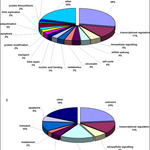Cancer Research

Nanobiotechnology holds a lot of promise and people have often speculated how it will impact the world of medicine. Unfortunately promising nanostructured systems so far have turned out to be extremely toxic to humans.
Now a group of researchers at the University of Michigan Nanotechnology Institute for Medicine and Biological Sciences have devised a multifunctional nanoparticle platform comprising nanoparticles synthesized within dendrimers equipped with targeting molecules and dyes. These dendrimer nanoparticle systems are able to seek out and specifically bind to cancer cells.
Xiangyang…

A diet rich in omega-3 polyunsaturated fatty acids found in certain fish or fish oil, nuts, seeds, and vegetable oils may help lower prostate cancer risk in individuals with a genetic predisposition to cancer.
While many genetic mutations are known to predispose to cancer, it has remained unclear whether dietary fat can modulate the risk of developing cancer in genetically predisposed individuals. Some studies suggest that a diet rich in omega-3 polyunsaturated fatty acids reduces cancer incidence.
To determine the influence of fatty acids on prostate cancer risk in animals with a defined…

Human resistance to a retrovirus that infected chimpanzees and other nonhuman primates 4 million years ago ironically may be at least partially responsible for the susceptibility of humans to HIV infection today.
These findings, reported by a team of researchers at Fred Hutchinson Cancer Research Center in the June 22 issue of Science, provide a better understanding of this modern pandemic infection through the study of an ancient virus called Pan troglodytes endogenous retrovirus, or PtERV1.
"This ancient virus is a battle that humans have already won. Humans are not susceptible to it and…
Using mathematical theory, UC Irvine scientists have shed light on one of cancer’s most troubling puzzles -- how cancer cells can alter their own genetic makeup to accelerate tumor growth. The discovery shows for the first time why this change occurs, providing insight into how cancerous tumors thrive and a potential foundation for future cancer treatments.
UCI mathematicians Natalia Komarova, Alexander Sadovsky and Frederic Wan looked at cancer from the point of view of a tumor and asked: What can a tumor do to optimize its own growth" They focused on the phenomenon of genetic instability, a…

It may not seem so at the time, but women who suffer through morning sickness during their pregnancies actually may be fortunate.
Those women may have a 30 percent lower risk of developing breast cancer later in life than mothers-to-be who experience nine nausea-free months, a new study by epidemiologists at the University at Buffalo suggests.
“Although the exact mechanism responsible for causing nausea and vomiting during pregnancy has yet to be pinpointed, it likely is a result of changing levels of ovarian and placental hormone production, which may include higher circulating levels of a…

Scientists have long thought that microtubules, part of the microscopic scaffolding that the cell uses to move things around in order to hold its shape and divide, originated from a tiny structure near the nucleus, called the centrosome.
Now, researchers at Vanderbilt University Medical Center reveal a surprising new origin for these cellular "highways." Irina Kaverina, Ph.D., and colleagues report that the Golgi apparatus -- a stack of pancake-shaped compartments that sorts and ships proteins out to their cellular destinations -- is the source of a particular subset of these microscopic…

Researchers say they have discovered the gene that regulates stem cell ability to self-renew and to differentiate into highly specialized types. This means they could program stem cells to become certain cells or do repair automatically.
“You could call this a ‘theory-of-everything’ for stem cells,” said senior author Dr. Michael Rudnicki, Senior Scientist and Professor at the Ottawa Health Research Institute and the University of Ottawa, referring to the often-cited theory of everything for physics.
For more than 25 years, stem cells have been defined based on what they can become: more of…

The significance of pleiotrophin (PTN) expression in breast cancer has not been clearly established but researchers at Scripps sau they have done it in a new study. These new findings could lead to a better understanding of the molecular pathogenesis of breast cancer and focus attention on PTN and its signaling pathway as possible targets for new cancer therapies.
The study also found that the expression of pleiotrophin activated surrounding cells to remodel the tumor microenvironment, induced tumor angiogenesis, and increased the number of receptors for different markers of aggressive breast…

University of Tennessee professor Alan Solomon, director of the Human Immunology and Cancer/Alzheimer’s Disease and Amyloid-Related Disorders Research Program, led a team that discovered a link between foie gras prepared from goose or duck liver and the type of amyloid found in rheumatoid arthritis or tuberculosis.
Their experimental data has provided the first evidence that a food product can hasten amyloid development.
Amyloidosis is a disease process involving the deposit of normal or mutated proteins that have become misfolded. In this unstable state, such proteins form hair-like fibers…
Genes account for only 2.5 percent of DNA in the human genetic blueprint, yet diseases can result not only from mutant genes but from mutations of other DNA that controls genes. University of Utah researchers report they have developed a faster, less expensive technique for mutating those large, non-gene stretches of DNA.
“Diseases are known to occur as a consequence of deleting non-gene DNA sequences, and this new method allows us to evaluate what these sequences do,” says Mario Capecchi, distinguished professor and co-chair of human genetics at the University of Utah and an investigator for…